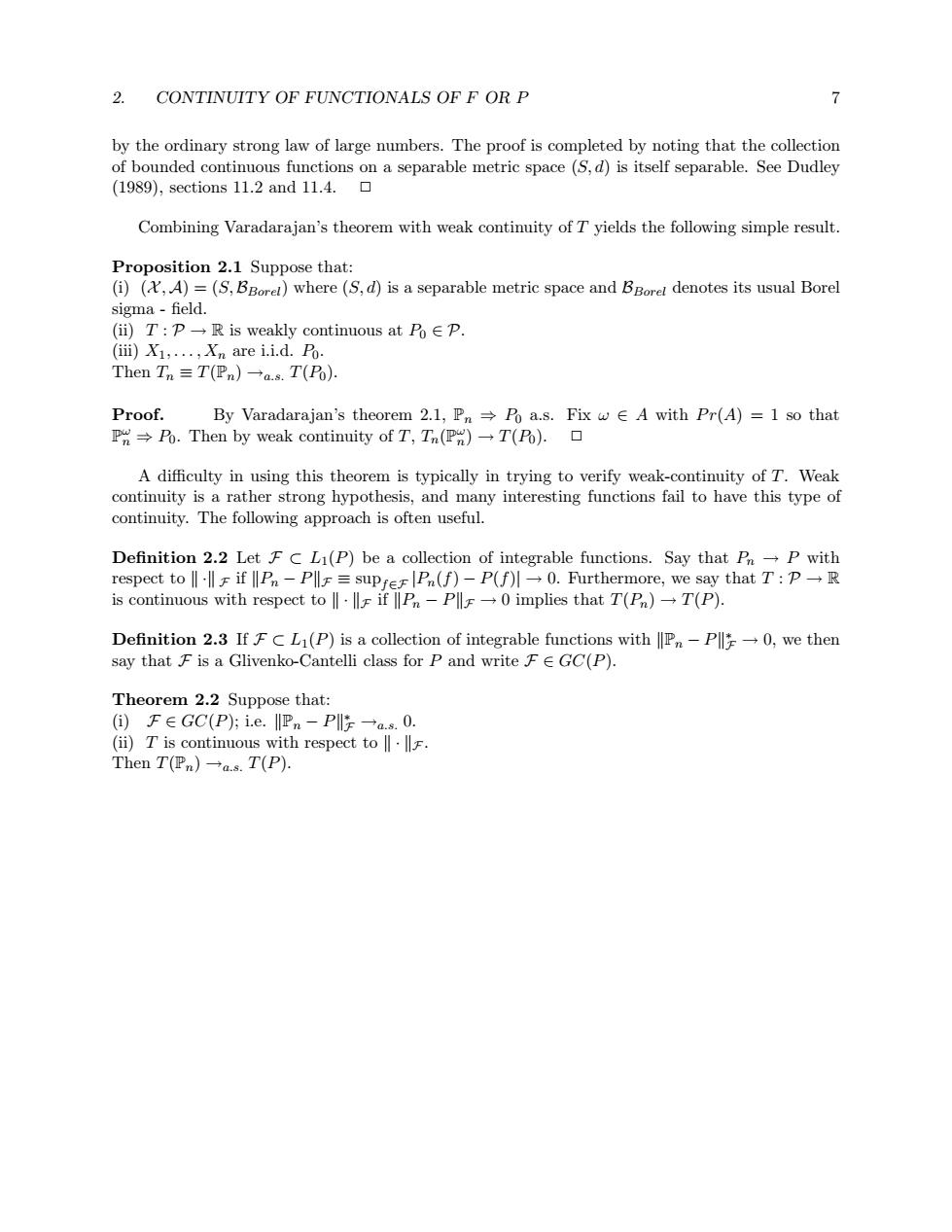正在加载图片...

2 CONTINUITY OF FUNCTIONALS OF F OR P 7 by the ordinary strong law of large numbers.The proof is completed by noting that the collection of bounded continuous functions on a separable metric space (S,d)is itself separable.See Dudley (1989),sections 11.2 and 11.4. Combining Varadarajan's theorem with weak continuity of T yields the following simple result. Proposition 2.1 Suppose that: (i)(,A)=(S,BBoret)where (S,d)is a separable metric space and BBoret denotes its usual Borel sigma-field. (i)T:P→R is weakly continuous at Po∈P. (iii)X1,...,Xn are i.i.d.Po. Then Tn≡T(Pn)→a.s.T(Po): Proof. By Varadarajan's theorem 2.1,Pn Po a.s.Fix wE A with Pr(A)=1 so that P%→Po.Then by weak continuity of T,Tn(P%)→T(Po).口 A difficulty in using this theorem is typically in trying to verify weak-continuity of T.Weak continuity is a rather strong hypothesis,and many interesting functions fail to have this type of continuity.The following approach is often useful. Definition 2.2 Let FC Li(P)be a collection of integrable functions.Say that PnP with respect to‖‖F if llPn-Plr=supfer|Pn(f)-P(f川一0.Furthermore,.we say that T:P→R is continuous with respect to‖·.F if Pn-PllF→0 implies that T(Pn)→T(P). Definition 2.3 IfFCL(P)is a collection of integrable functions with Pn-P0,we then say that F is a Glivenko-Cantelli class for P and write FE GC(P). Theorem 2.2 Suppose that: ()F∈GC(P);i.e.Pn-Pl一as.0. (ii)T is continuous with respect to‖l·lF Then T(Pn)→a.s.T(P).2. CONTINUITY OF FUNCTIONALS OF F OR P 7 by the ordinary strong law of large numbers. The proof is completed by noting that the collection of bounded continuous functions on a separable metric space (S, d) is itself separable. See Dudley (1989), sections 11.2 and 11.4. ✷ Combining Varadarajan’s theorem with weak continuity of T yields the following simple result. Proposition 2.1 Suppose that: (i) (X , A)=(S,BBorel) where (S, d) is a separable metric space and BBorel denotes its usual Borel sigma - field. (ii) T : P → R is weakly continuous at P0 ∈ P. (iii) X1, . . . , Xn are i.i.d. P0. Then Tn ≡ T(Pn) →a.s. T(P0). Proof. By Varadarajan’s theorem 2.1, Pn ⇒ P0 a.s. Fix ω ∈ A with P r(A) = 1 so that Pω n ⇒ P0. Then by weak continuity of T, Tn(Pω n) → T(P0). ✷ A difficulty in using this theorem is typically in trying to verify weak-continuity of T. Weak continuity is a rather strong hypothesis, and many interesting functions fail to have this type of continuity. The following approach is often useful. Definition 2.2 Let F ⊂ L1(P) be a collection of integrable functions. Say that Pn → P with respect to . ·. F if .Pn − P.F ≡ supf∈F |Pn(f) − P(f)| → 0. Furthermore, we say that T : P → R is continuous with respect to . · .F if .Pn − P.F → 0 implies that T(Pn) → T(P). Definition 2.3 If F ⊂ L1(P) is a collection of integrable functions with .Pn − P.∗ F → 0, we then say that F is a Glivenko-Cantelli class for P and write F ∈ GC(P). Theorem 2.2 Suppose that: (i) F ∈ GC(P); i.e. .Pn − P.∗ F →a.s. 0. (ii) T is continuous with respect to . · .F . Then T(Pn) →a.s. T(P)